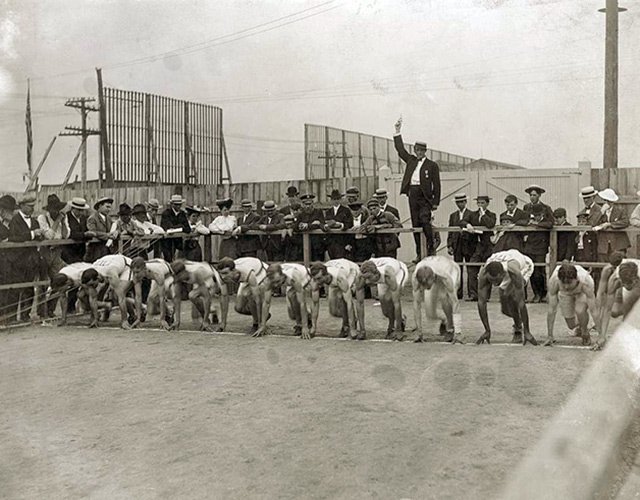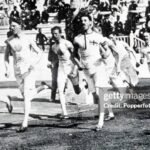Like the 1900 Olympics in Paris, the 1904 Games took a secondary role. The Games originally were scheduled for Chicago, but the location was changed to St. Louis when Olympic organizing committee officials decided to combine the Olympics with the Louisiana Purchase Exhibition, a large fair celebrating the 100th anniversary of the U.S. acquisition of the Louisiana Territory. As a result, the Games suffered. Several events became part of an “anthropological” exhibition in which American Indians, Pygmies, and other “tribal” peoples competed in events such as mud fighting and pole climbing. The Games were poorly attended by both spectators and athletes. The remoteness of St. Louis and growing tension in Europe over the Russo-Japanese War kept away many of the world’s best athletes. Of the approximately 650 competitors representing 12 countries, fewer than 100 were from outside the United States, and about half of those were from Canada. Even the Olympic founder, Coubertin, stayed away in 1904.
The overall results were predictably lopsided, with Americans earning more than three-fourths of the 95 gold medals and more than 230 medals in all. The track-and-field events, held on the campus of Washington University, featured Ray Ewry, who repeated his Paris performance by winning gold medals in all three standing-jump events. American athletes Archie Hahn, Jim Lightbody, and Harry Hillman each won three gold medals as well. Thomas Kiely of Ireland, who paid his own fare to the Games rather than compete under the British flag, won the gold medal in an early version of the decathlon. Kiely and his competitors performed the 100-yard sprint, shot put, high jump, 880-yard walk, hammer throw, pole vault, 120-yard hurdles, 56-pound weight throw, long jump, and mile run, all in a single day. The swimming events took place in an artificial lake on the fairgrounds. Zoltán Halmay of Hungary and Charles Daniels of the United States each won two gold medals in individual swimming, while Emil Rausch of Germany won three. Boxing made its Olympic debut in 1904.
Indigenous American peoples

Indigenous American peoples, any of the aboriginal peoples of the Western Hemisphere. Inuit, Yupik/Yupiit, and Unangan (Aleuts) are sometimes excluded from this category, because their closest genetic and cultural relations were and are with other Arctic peoples rather than with the groups to their south.
The ancestors of contemporary Indigenous American peoples were members of nomadic hunting and gathering cultures. The earliest of these peoples to reach the Americas traveled in small family-based bands that moved from Asia to North America during the last ice age; from approximately 30,000–12,000 years ago, sea levels were so low that a “land bridge” connecting the two continents was exposed.
High jump
high jump, sport in athletics (track and field) in which the athlete takes a running jump to attain height. The sport’s venue (see illustration) includes a level, semicircular runway allowing an approach run of at least 15 metres (49.21 feet) from any angle within its 180° arc. Two rigid vertical uprights support a light horizontal crossbar in such a manner that it will fall if touched by a contestant trying to jump over it. The jumper lands in a pit beyond the bar that is at least 5 by 3 metres (16.4 feet by 9.8 feet) in size and filled with cushioning material. The standing high jump was last an event in the 1912 Olympics. The running high jump, an Olympic event for men since 1896, was included in the first women’s Olympic athletics program in 1928.

Decathlon

decathlon, athletic competition lasting two consecutive days in which contestants take part in 10 track-and-field events. It was introduced as a three-day event at the Olympic Games in 1912. Decathlon events are: (first day) 100-metre dash, running long (broad) jump, shot put, high jump, and 400-metre run; (second day) 110-metre hurdles, discus throw, pole vault, javelin throw, and 1,500-metre run. Competitors are scored for their performance in each event according to a table established by the International Association of Athletics Federations (IAAF).
The table has been changed periodically to keep pace with improvements in world records. The first one was used from 1912 to 1936, while the decathlon was still a three-day event; a second from 1936 to 1950 (with minor revisions in 1952); and a third from 1952 to 1964. All emphasized excellent performances in the individual events. A fourth table in use from 1964 to 1985 and a fifth introduced in 1985 favoured the athlete who could score evenly in all 10 events.


